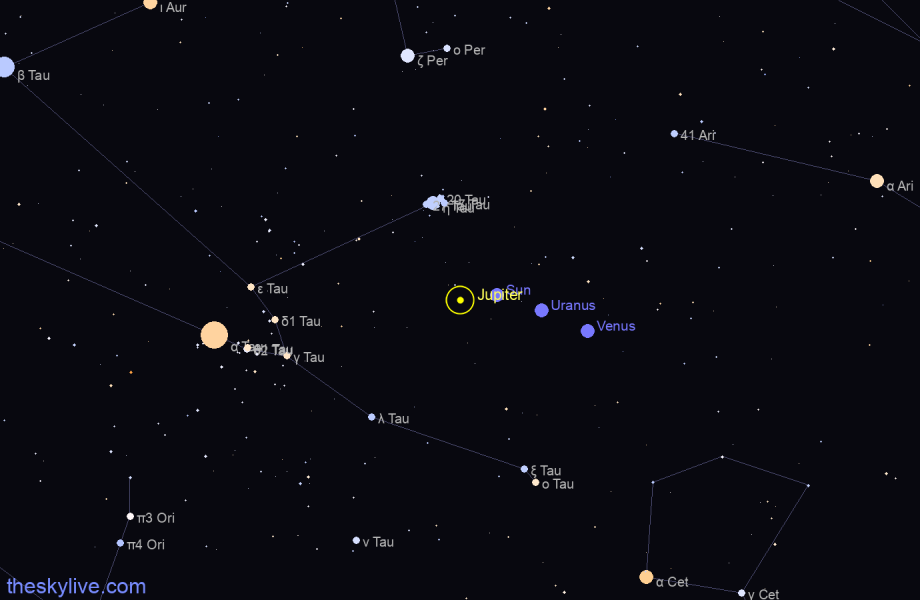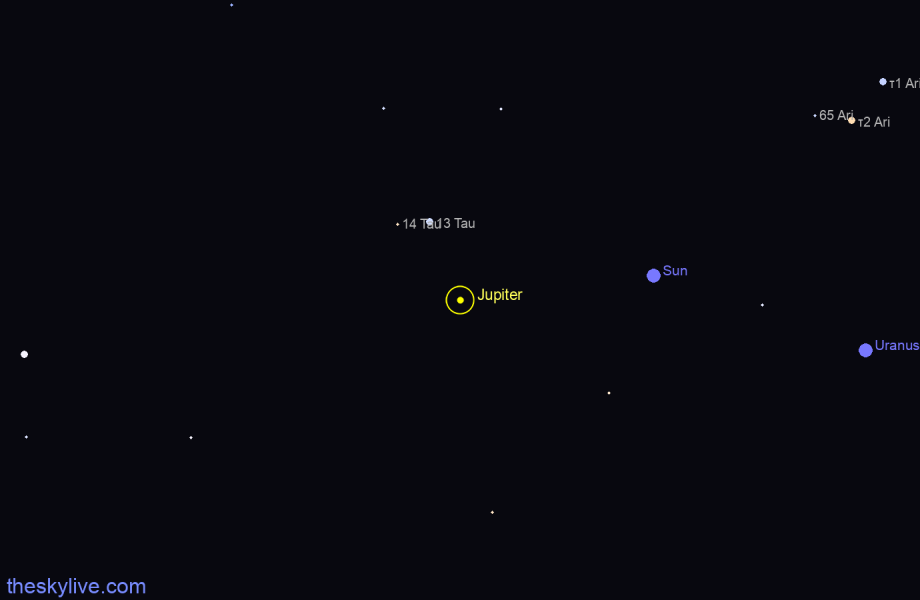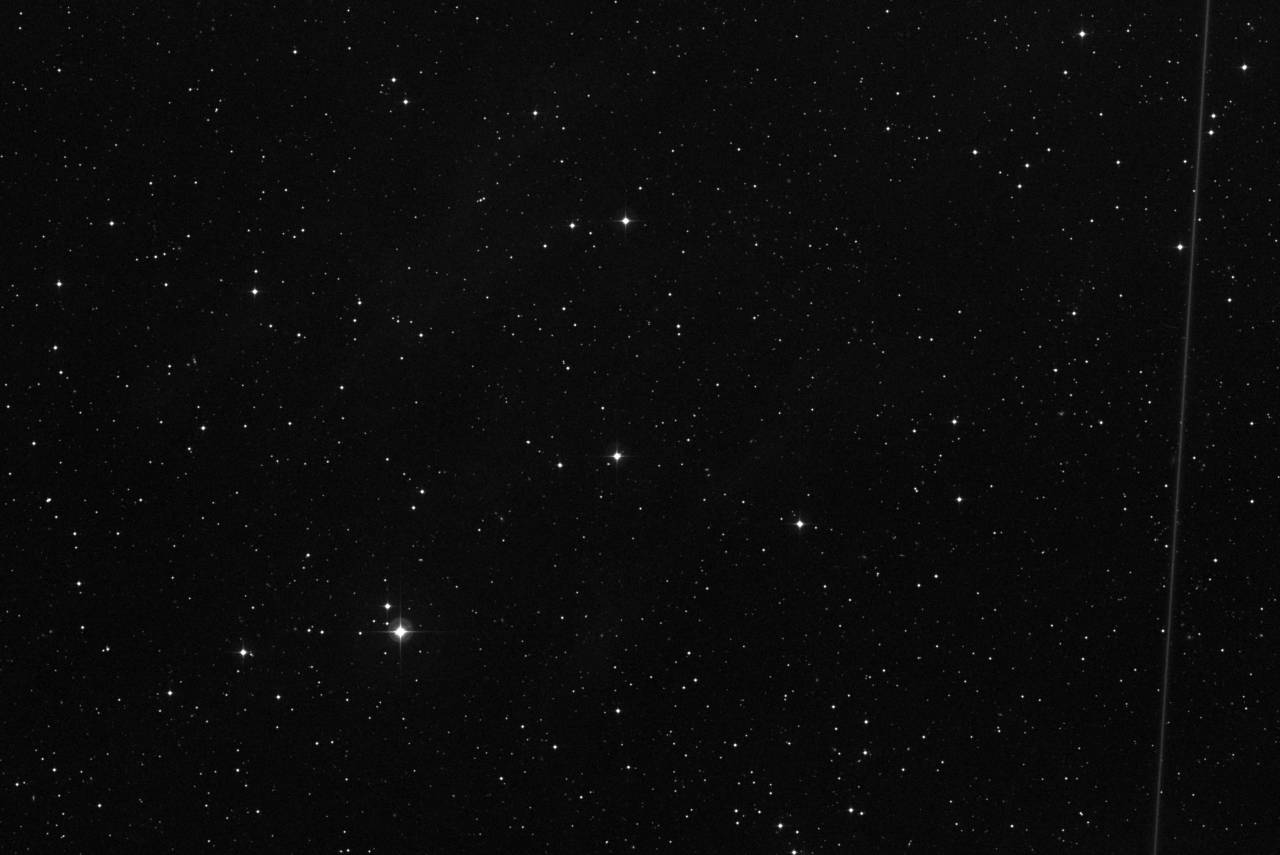Jupiter
Jupiter is the largest planet in the Solar System, located fifth from the sun. It has a diameter of 139,822 kilometers and a mass of 1.898 x 10^27 kilograms, making it more than twice as massive as all the other planets in the Solar System combined. Jupiter is a gas giant planet composed mostly of hydrogen and helium, with a small rocky core at its center. The planet has a banded appearance, with swirling cloud formations and a famous Great Red Spot, a persistent high-pressure storm in the planet's atmosphere that is larger than the size of Earth. Jupiter has a rapid rotation, with a day length of 9.9 hours, and it orbits the sun once every 11.86 Earth years. The planet has 79 known moons, including four large Galilean moons: Io, Europa, Ganymede, and Callisto. Jupiter has been explored by multiple spacecraft, including the Galileo mission and NASA's Juno mission, which is currently in orbit around the planet.
Jupiter is currently in the constellation of Aries, at a distance of 893,037,364 kilometers from Earth.
View interactive star map
Today's rise, transit and set times of Jupiter from Greenwich, United Kingdom (all times relative to the local timezone Europe/London):
- Jupiter is above the horizon from Greenwich, United Kingdom .
- Right now it is placed in the West-North-West direction at an altitude of 2° above the horizon.
- Given its current magnitude, Jupiter is visible to the naked eye, easily even from highly light polluted areas.
- Go to interactive sky chart
If you need to access this information frequently for your observations, you can create a simple customized Quick Access page, so that you can easily bookmark it in your browser favorites or add a shortcut to your mobile phones' home screen.
Higher precision deep sky finder chart, 60 arcmin wide, showing where Jupiter is right now. Click on the image to see a more detailed fullscreen tracker view.
Also check out Where is Jupiter?, a page that provides all the information needed to find Jupiter in the sky and additional links to sky charts.
Jupiter Distance from Earth
The distance of Jupiter from Earth is currently 893,037,364 kilometers, equivalent to 5.969586 Astronomical Units. Light takes 49 minutes and 38.8520 seconds to travel from Jupiter and arrive to us.
The following chart shows the distance of Jupiter from Earth as a function of time. In the chart the distance data is measured in Astronomical Units and sampled with an interval of 1 day.
The value of the reported distance might be somewhat inaccurate around the times of closest approach for objects passing extremely close to Earth. The value of the distance of Jupiter from Earth is also available as a real time updated value in the Live Position and Data Tracker.
Closest Approach of Jupiter to Earth
Between 1 January 1600 and 30 December 2499, the closest approach of Jupiter to Earth happens on Tue Oct 16 2485 at a distance of 3.943792 Astronomical Units, or 589,982,961 kilometers:
NOTE: values for the closest approach are computed with a sampling interval of 1 day.
Jupiter Brightness and Light Curve
The following chart is the predicted light curve (visual magnitude as a function of time) of Jupiter, according to the most recent ephemerides data. Magnitude data is sampled with a 2 days interval and there might be inaccuracies for objects changing brightness very rapidly during the course of a few days. For comets there could be large discrepancies between the observed and predicted brightness because of their highly dynamic behaviour.
Jupiter Physical Data
The following shows the known values of the most important physical parameters of Jupiter. Source: JPL Small-Body Database
| Physical Parameter | Value | Relative to Earth |
|---|---|---|
| Diameter | 139822 km | 10.9733 |
| Mass | 1898.13 x 1024 kg | 317.8281 |
| Density | 1.3262 gr/cm3 | 0.2405 |
| Escape Velocity | 60.2 km/s | 5.3798 |
| Sideral Rotation | 9.9250 hours | 0.4147 |
| Absolute Magnitude | -9.4 | |
| Geometric Albedo | 0.52 |
Jupiter 15 Days Ephemeris
The following table lists the ephemerides of Jupiter computed for the past and next 7 days, with a 24 hours interval. Click on each row of the table to locate Jupiter in our Online Planetarium at the chosen date.
| Date | Right AscensionR.A. | DeclinationDec. | MagnitudeMag | Apparent DiameterDiameter | Constellation |
|---|---|---|---|---|---|
| 2024 Apr 19 | 03h 15m 11s | +17° 15’ 23” | -2.02 | 32.5” | Aries |
| 2024 Apr 20 | 03h 16m 06s | +17° 19’ 05” | -2.02 | 32.5” | Aries |
| 2024 Apr 21 | 03h 17m 02s | +17° 22’ 45” | -2.02 | 32.5” | Aries |
| 2024 Apr 22 | 03h 17m 57s | +17° 26’ 26” | -2.02 | 32.4” | Aries |
| 2024 Apr 23 | 03h 18m 53s | +17° 30’ 06” | -2.02 | 32.4” | Aries |
| 2024 Apr 24 | 03h 19m 50s | +17° 33’ 46” | -2.02 | 32.4” | Aries |
| 2024 Apr 25 | 03h 20m 45s | +17° 37’ 24” | -2.01 | 32.3” | Aries |
| 2024 Apr 26 | 03h 21m 42s | +17° 41’ 03” | -2.01 | 32.3” | Aries |
| 2024 Apr 27 | 03h 22m 37s | +17° 44’ 39” | -2.01 | 32.3” | Aries |
| 2024 Apr 28 | 03h 23m 35s | +17° 48’ 15” | -2.01 | 32.3” | Aries |
| 2024 Apr 29 | 03h 24m 32s | +17° 51’ 51” | -2.01 | 32.2” | Taurus |
| 2024 Apr 30 | 03h 25m 27s | +17° 55’ 27” | -2.01 | 32.2” | Taurus |
| 2024 May 01 | 03h 26m 25s | +17° 59’ 00” | -2.01 | 32.2” | Taurus |
| 2024 May 02 | 03h 27m 21s | +18° 02’ 34” | -2.01 | 32.2” | Taurus |






